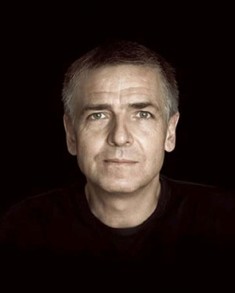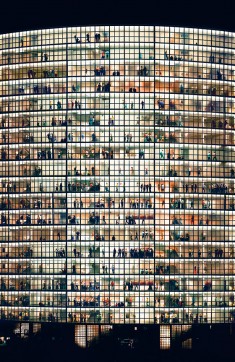| Andreas Gursky | |
|---|---|
 |
|
| Photographer | |
| Born | Jan. 15, 1955 |
| Nationality | German |
Andreas Gursky is a German photographer. His work is particularly noted for his photographs of landscapes and architecture, which are frequently taken from an elevated vantage point. A photograph by Gursky, Rhein II, is the most expensive photograph ever to come to auction, selling for $4.3 million in 2011.
He has exhibited at many major events, including the Venice Bienniale, and has won a number of photography awards. Although he has used color almost from the beginning of his professional career, this aspect of his art has become increasingly significant in recent years.
Early Life
Gursky was born in the East German city of Leipzig on January 14, 1955. At the time it was relatively straightforward for people to move to West Germany, and his family did this when he was two years old, eventually settling in Düsseldorf. His parents owned a photographic studio, but the boy was initially uninterested in going into the same business.
During his time at the Folkwangschule in Essen in the late 1970s and early 1980s, he supported himself by working as a taxi driver. He attempted to gain employment in photojournalism, but was unsuccessful and instead enrolled at the Düsseldorf Kunstakadamie.
Educational Years
In Dusseldorf, Gursky studied under Hilla and Bernd Becher, who generally shot in black and white. However, Gursky chose to work exclusively in color after the first year. In 1987, he put on his debut exhibition at the Düsseldorf Airport. This showed photos taken over a four-year period of security staff in the lobbies of office blocks all over Germany.
In the same year, he was awarded his diploma. By this time, he was photographing extensively in the Ruhr Valley, concentrating particularly on the contrast between industry and the natural environment. He also took meticulously observed pictures of people at leisure outdoors.
Gursky’s Mature Work
 By the end of the 1980s, Gursky had progressed to solo museum and gallery exhibitions, assisted in his career by the increasing demand for photography on the international stage. He became fairly wealthy and was able to travel all over the world in the 1990s to take architectural photos.
By the end of the 1980s, Gursky had progressed to solo museum and gallery exhibitions, assisted in his career by the increasing demand for photography on the international stage. He became fairly wealthy and was able to travel all over the world in the 1990s to take architectural photos.
Although he visited places as far away as Singapore, Hong Kong, and Cairo, he did not abandon his work in Germany. Over a period of several years, he was commissioned to take photographs of a number of factories owned by Siemens. By now he was using the largest paper he could find for his prints, and he went further by the turn of the century, with some of his images more than 15 feet along their longest side.
More Current Works and Style
From about 2000, Gursky started to employ digital editing and retouching techniques, as well as making use of increasing levels of computing power to create large panoramas. His Stockholder Meeting of 2001 was produced entirely digitally.
In more recent years, he has continued to focus on architecture and landscapes, as well as crowds of people in various settings. Gursky was the subject of two large touring exhibitions in 2007, by which time he was considered at the very forefront of his field. He had by then twice shown his work at the Venice Bienniale, as well as being awarded the Infinity Award for Art in 2001. He now lives and works in an unused Düsseldorf power station.